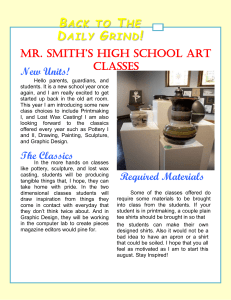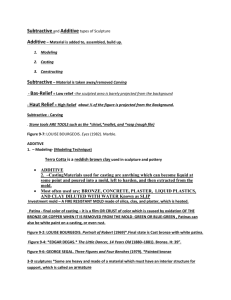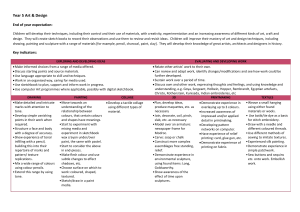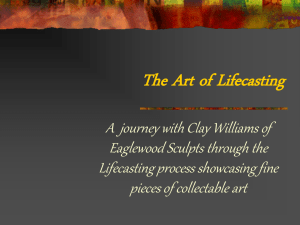Artnet: Art Glossaries - Manchester Cultural Partnership
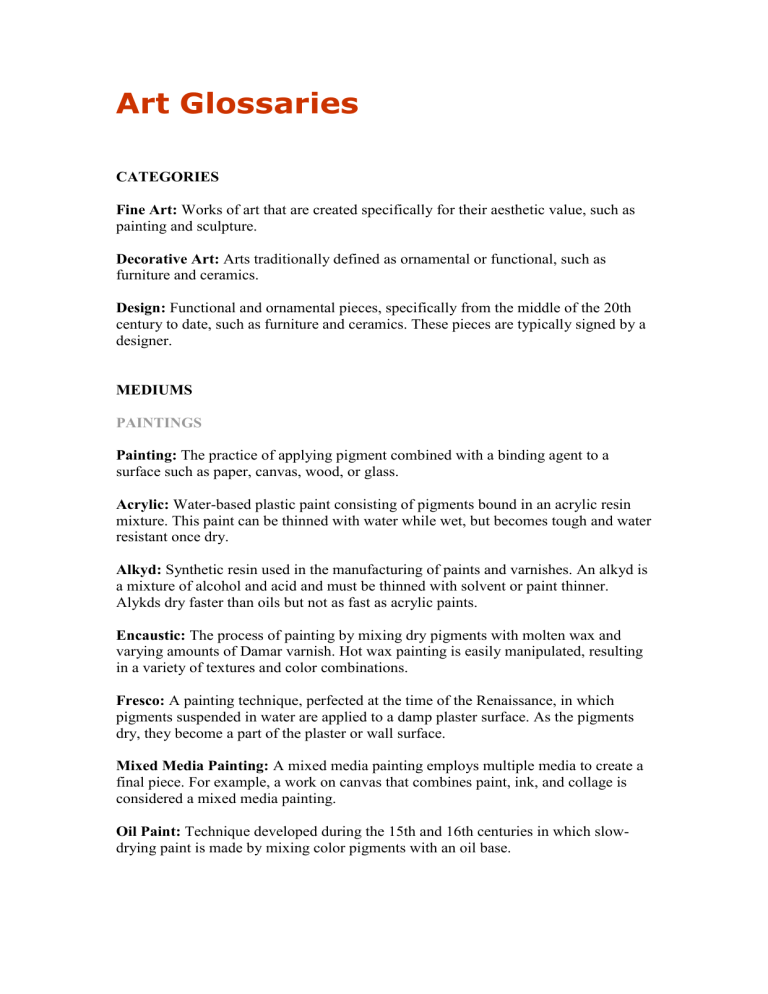
Art Glossaries
CATEGORIES
Fine Art: Works of art that are created specifically for their aesthetic value, such as painting and sculpture.
Decorative Art: Arts traditionally defined as ornamental or functional, such as furniture and ceramics.
Design: Functional and ornamental pieces, specifically from the middle of the 20th century to date, such as furniture and ceramics. These pieces are typically signed by a designer.
MEDIUMS
PAINTINGS
Painting: The practice of applying pigment combined with a binding agent to a surface such as paper, canvas, wood, or glass.
Acrylic: Water-based plastic paint consisting of pigments bound in an acrylic resin mixture. This paint can be thinned with water while wet, but becomes tough and water resistant once dry.
Alkyd: Synthetic resin used in the manufacturing of paints and varnishes. An alkyd is a mixture of alcohol and acid and must be thinned with solvent or paint thinner.
Alykds dry faster than oils but not as fast as acrylic paints.
Encaustic: The process of painting by mixing dry pigments with molten wax and varying amounts of Damar varnish. Hot wax painting is easily manipulated, resulting in a variety of textures and color combinations.
Fresco: A painting technique, perfected at the time of the Renaissance, in which pigments suspended in water are applied to a damp plaster surface. As the pigments dry, they become a part of the plaster or wall surface.
Mixed Media Painting: A mixed media painting employs multiple media to create a final piece. For example, a work on canvas that combines paint, ink, and collage is considered a mixed media painting.
Oil Paint: Technique developed during the 15th and 16th centuries in which slowdrying paint is made by mixing color pigments with an oil base.
Tempera: A medium that was prevalent in Orthodox paintings during Southern
Europe’s Middle Ages. The artist combines egg yolk, egg white, and oil to bind a range of pigments on a rigid support such as wood paneling.
PHOTOGRAPHY
Photography: The art of recording images by capturing light on surfaces sensitized by a chemical process.
Albumen Print: An albumen print is created by the process developed by Louis
Desire Blanquart-Evrard in 1850. This process uses egg whites and photographic chemicals to produce a print on paper from a negative.
Autochrome: Autochrome refers to the color “screen-plate” process developed by the
Lumiere brothers in 1903. It was the principal color photography process until it was replaced by color film in the mid-1930s.
Calotype: A calotype is a photomechanical method for reproducing photographic images. While it is no longer practiced as a commercial process, it was considered the height of Fine Art photography beginning in the 1970s.
Carbon Print: First produced in 1864 by Joseph Wilson Swan, a carbon print is a photographic print created by immersing a carbon tissue in a solution of potassium bichromate, carbon, gelatin, and a coloring agent.
C-Print: Developed in 1930, the c-print is the most universal type of color photograph, created using at least three emulsion layers of light sensitive silver salts.
Each layer is sensitized to a specific primary color. As a result, each layer records different information for the color make up of an image.
Collodion Negative: A collodion negative is produced by the colorless, high quality duplication process developed by Frederick Scott Archer and Gustave Le Gray in
1850.
Cyanotype: Cyanotype is an older printing method which uses a monochrome photographic process to produce a cyan-blue print.
Daguerreotype: The Daguerreotype was the first commercial photographic process.
Named for Louis-Jacques Monde Daguerre, it is a positive print on a light-sensitive copper plate.
Digital Print: Digital photography refers to electronically captured images composed of digital values, or pixels. Iris prints, giclee prints, and digital archival prints are three examples of popular digital printing methods.
Dye Destruction Print: Dye destruction prints are characterized by their vibrant color. These prints are created using three emulsion layers, each one specifically sensitized to a different primary color and containing a dye relevant to that color.
During this process, different information is recorded from each layer creating the final image in which three layers are perceived as one.
Dye Transfer Print: Dye transfer prints are created from three separate negatives by photographing the original negative through red, green, and blue filters. The result is a richly colored image on gelatin coated paper.
Montage/Photomontage: This term refers to a single image formed from assembling many existing images such as photographs or prints.
Photogenic Drawing: Photogenic drawing was the first cameraless photographic process, discovered by William Fox Talbot in 1839. Talbot used a high quality sheet of paper which was immersed in a solution of table salt. After the paper dried, he brushed it with silver nitrate, which created a light sensitive surface, and placed small objects such as leaves and lace on the paper. The result was a light image of the object against a dark background, or a negative image.
Photogram: This process, created without the use of a camera, records photosensitive material by exposing it to light. Similar to an X-ray, the final image records silhouetted images on photographic paper.
Photogravure: Developed in the 1830s by Henry Fox Talbot, photogravure, the intaglio printmaking process, produces images from a flat, etched copper plate.
Platinum Print: Created in 1873 by William Willis, platinum prints utilize the light sensitivity of iron salts to produce an image. During the developing process, chemical reactions dissolve the iron salts and replace them with platinum. Platinum prints were extremely popular until the 1920s, when the price of platinum rose and became too expensive. They are valued for their range of tonal variations and permanence.
Polaroid: Polaroid refers to the synthetic plastic sheet used to polarize light, typically associated with the instant camera and self-developing film.
Salt Print: The earliest form of photographic positive paper, salt prints were the most common print type until the invention of the albumen. Developed in 1840 by William
Fox Talbot, they were created by soaking a sheet of paper in a salt solution and coating it with silver nitrate. This created a light sensitive paper which typically produced sepia prints with a matte surface.
Silver Print: Silver prints are created by the most common method for producing black-and-white prints in photography. These prints are generated using papers coated with gelatin that contain light-sensitive silver salts. By 1895, the gelatin silver print had replaced the Albumen print, because it did not yellow with age and was easier to produce.
Woodburytype: The term woodburytype refers to the photomechanical process in which continuous tone is created in slight relief. In this process, a gelatin film is exposed under a photographic negative and hardened according to the amount of light. The film is then placed in hot water, to remove all unexposed gelatin, dried, and
pressed into a sheet of lead. As a result, an intaglio plate is created, filled with pigmented gelatin, and pressed onto paper producing a final image.
PRINTMAKING
Printmaking: Process in which a work can be recreated from a single image.
Intaglio Methods: Intaglio includes the engraving, etching, and drypoint methods of printmaking, and is produced via cuts made in a metal surface. These incised areas are then filled with ink and rolled through a press, thus transferring an image to paper. All intaglio prints have platemarks.
Aquatint: In this intaglio method of printmaking, a porous ground coats a metal plate, which is then immersed in acid, allowing an even biting of the plate. The resulting image has a grainy and textural effect.
Chine Colle: A chine colle print is created by affixing layers of thinner sheets of paper to a heavier sheet, and then making an intaglio impression. The thinner top sheets take the impression much more easily than a heavier paper, creating a sense of depth in the printed image, both physically and visually.
Drypoint: Often used in combination with engraving or etching techniques, lines are scratched or gouged onto a metal plate creating a burr. The raised burr is quite pronounced and is not eliminated when printing, resulting in a heavier line than with engraving alone.
Engraving: The most popular of the intaglio methods of printmaking. An engraved print is created by scratching or cross-hatching into the surface of a polished metal plate. The plate is then inked, covered with a sheet of paper, and run through a press.
The areas of the plate which are incised print, transferring the final image to paper.
Etching: Etching refers to the process of using acid to cut into a metal plate. After the plate has “etched,” it is covered with ink and run through the press revealing the etched image on paper.
Mezzotint: In this method of printmaking, the artist creates a dark base on a metal plate using a cutting instrument called a "rocker." Then, using a scraper, the artist burnishes the plate in the areas in which he desires to achieve a lighter color. Finally, the artist inks the plate and rolls it through a press topped with a piece of paper in order to create the final image.
Mixed Method Engraving: This is a method of intaglio printmaking which combines two or more methods.
Photogravure: Developed in the 1830s by Henry Fox Talbot, photogravure is an intaglio printmaking process in which an image is transferred to a flat, etched copper plate, hand-inked, and printed.
Steel Engraving: Steel engravings utilize plates composed of a harder metal, as opposed to the traditional copper plate. This method is preferable when creating designs intended for large editions, as the plate will not degrade as rapidly.
Stipple Engraving: Rather than etching lines, the design in this method of printmaking is created by applying large numbers of incised dots to the plate’s surface, similar to Pointillism in painting.
Planographic Methods: Planographic methods include all types of prints which are drawn on a flat surface and run through a press.
Lithography: Lithography is a method of printmaking based on the concept of the repulsion of oil and water. In this process, the artist uses a grease-based chalk to draw an image on stone. An oil-based ink is then applied to the stone's surface, allowing the ink to stick to the greased areas of the stone. The stone is then inked, and the image is transferred to paper, after being run through a press.
Chromolithography: This term refers to any lithograph that is printed in color. A chromolithograph requires a separate printing for each color.
Relief Methods: A relief print is one in which a material, such as part of a wood block, a piece of linoleum, a metal plate, or another carvable material, is left in relief to be printed black, and the remainder is cut away.
Embossing: Embossing is the process of creating an impression of an image that results in a raised surface. This can be done alone (blind embossing) or over an already printed image.
Linocut: The linocut is a 20th century variation on the woodcut. It is created in the same manner, except that a piece of linoleum, which is soft and pliable, is used instead of wood.
Ukiyo-e: Literally translated, this means "pictures of the floating world." A Ukiyo-e is a traditional Japanese woodblock print dating from the Edo period (1603–1867).
Woodcut: A printmaking method in which the artist works on a plank of wood, cutting away the parts of the design which are not to be printed. The wooden surface is then inked, covered with a sheet of paper, and run through a press.
Wood Engraving: A wood engraving is a variation on the woodcut. Differing from a woodcut, it is done using the cut end of a piece of wood, as opposed to the plank side.
Harder wood is typically employed to create a finer line in comparison to the soft, heavy lines associated with woodcuts.
Stenciling Methods: This printmaking method refers to the principle of cutting or creating a hole in a protected surface and applying color through the hole to the surface beneath.
Serigraph or Silk-Screen: Serigraphs, also known as silk-screens, are created from a special type of stencil. A screen is made of porous fabric and stretched over a wood or
aluminum frame. Parts of the screen are covered with non-permeable material, forming a stencil. The areas which allow ink to pass freely create the final image, which can be printed on a number of different materials, including fabric and paper.
Pochoir: Defined as "stencil" in French, a pochoir print is hand-colored and created with a series of carefully cut stencils. This method of printmaking was most prevalent during the early part of the 20th century in Paris, and was frequently used for fashion plates during the Art Deco period.
Monotype or Monoprint: The monotype/monoprint incorporates both printmaking and painting, producing a single impression by using pressure to transfer a painted image to paper.
SCULPTURE
Sculpture: A three-dimensional work of art created through carving, modeling, casting, and construction.
Acrylic/Plastic: A synthetic material made from the polymerization of organic compounds.
Brass: An alloy of zinc and copper.
Bronze: A very dense alloy of 60% copper and 40% tin. Bronze is the most universally popular metal used in the casting of sculpture.
Composite: Composite materials are made from two or more substances with significantly different properties.
Glass: Glass refers to a uniform amorphous solid material created from the rapid cooling of molten materials.
Expendable Mold Casting: Expendable mold casting includes most methods which use mold making materials, such as sand, shell, plaster, and investment. A characteristic of these methods is their use of temporary, non-reusable molds.
Non-expendable Mold Casting: Non-expendable mold casting differs from expendable in that the molds do not have to be reformed after their initial cast. A few of the specific methods include permanent, die, centrifugal, and continuous.
Centrifugal Casting: A type of non-expendable mold casting, centrifugal casting is gravity and pressure-independent. In this method, molten metal is poured into the cavity of a spinning chamber.
Continuous Casting: A non-expendable casting method, continuous casting is used for high-volume production of metal sections. In this technique, the cast shape is continuously withdrawn through the bottom of the mold so that the specific dimensions of the mold do not determine the length of the sculpture.
Die Casting: In this non-expendable casting method, molten metals are forced into steel molds or dies.
Investment or Lost-Wax Casting: Investment casting, or the lost-wax process, is one of the oldest metal-forming methods. It is often an expensive process, but the intricate details and contours of the cast are well worth it. In this process, a wax original is enclosed in an outer mold. The wax is then melted and evacuated from the mold under high temperatures, and the resulting voids are filled with metal, producing the final sculpture.
Permanent Mold Casting: A form of non-expendable casting. Permanent mold casting is typically used for iron, aluminum, magnesium, and copper-based alloys. It is highly automated and requires weeks of preparation before the casting begins.
Plaster Casting: Similar to sand casting, patterns are sprayed with a thin film to prevent the mold from sticking, and then covered in plaster, which fills the small spaces around the pattern. The form is then removed and filled with metals such as aluminum, zinc and copper.
Cast Plaster, Concrete, or Plastic Resin: Plaster or concrete can also be cast using single waste or multiple piece molds. The final product lacks the aesthetic quality that most metals acquire after casting. Therefore, plaster, plastic, or concrete sculptures are typically painted to give the appearance of metal or stone.
Ceramic Shell Mold : This is a casting process which involves a sand and resin mold making mixture, which takes weeks to produce a final sculpture. There are at least a dozen stages in the shell mold process.
Sand Casting: Sand casting is typically used for low-temperature metals such as iron, copper, aluminum, magnesium, and nickel alloys. In this method, materials are poured into a mold of compacted sand. Sand cast sculpture is easily identified by its textured surface and lack of delicacy.
Waste Mold: In this expendable plaster mold casting method, a thin plaster mold is cast over an original clay model. When removed from the clay, the details of the clay are destroyed, but captured in the mold. This mold can then be used to cast metals with a low melting temperature, such as pewter, or water based casting compounds, such as plaster.
Ceramic: This term refers to clay objects fired at a high temperature, in a kiln, creating a ceramic form. While some ceramic pieces are classified as Fine Art, others are considered Decorative Art, Industrial Art, or Applied Art.
Copper: A reddish-brown metal. Copper surfaces are often finished with patina, which can range from brown to green.
Decoupage: Decoupage refers to a type of collage made from cutting patterns out of paper, or other materials, and affixing them upon a three-dimensional object.
Typically the surface is then varnished for preservation purposes.
Found Object Sculpture: Found object sculpture incorporates natural and/or manmade objects that are not typically considered art in and of themselves, but when combined by an artist, the result acquires aesthetic value.
Iron: A heavy, ductile, and magnetic metal which is often used in sculpture.
Mixed Media Sculpture: A mixed media sculpture employs multiple media to create a final piece.
Other Cast Metals: Other cast metals refers to a variety of unknown materials used for creating cast sculptures.
Other Synthetic Metals: Other synthetic metals refers to a variety of synthetic materials used to create sculptures.
Plaster: Plaster is a dry powdery medium, which, when mixed with water, forms a hardened paste. In the visual arts, it is most often used to cast clay models for sculpture.
Steel: An alloy of iron and carbon used in sculpture and architecture.
Stone: A hard medium composed of aggregate minerals, such as marble, limestone, or sandstone, used to produce three-dimensional objects. For the most part, sculptors use a hammer and chisel as the basic tools in the carving of stone.
Wood: The fibrous surface harvested from the trunks of trees. It can come in a variety of colors and patterns; wood's unique attributes contribute to its aesthetic quality.
WORKS ON PAPER
Works on Paper: Includes artworks drawn, painted or otherwise created on paper using a variety of media. The most common media used on paper are listed below.
Charcoal: Charcoal refers to the drawing utensil employed by artists as a medium for sketches, finished works, and under-drawings for paintings. The black and crumbly nature of charcoal produces a freer and less dense line than graphite.
Collage: The word collage derives from the French word "coller," which means to glue. In a collage, a work of art is created by clipping and adhering flat articles, such as photographs, newspaper, and fabric, to a two-dimensional surface.
Colored Pencil: Hand-held writing or drawing instruments typically used to create designs on paper.
Crayon: Sticks of colored wax used for writing and drawing.
Gouache: A painting medium similar to watercolor that is characterized by pigments suspended in water. However, due to the presence of chalk, gouache produces a heavier and more opaque image than a watercolor.
Graphite: A medium known for its greasy texture and metallic gray color, which can be easily removed with an eraser.
Ink/Wash: Ink is a liquid medium composed of a variety of pigments and dyes used to color a surface. It is often used for drawing or writing with a pen or brush. Thicker inks are used in letterpresses and lithographic printing.
Mixed Media Work on Paper: A mixed media work on paper employs multiple media to create a final piece.
Oil Paint: The technique developed during the 15th and 16th centuries in which slow drying paint is made by mixing color pigments with an oil base.
Pastel: Sticks of color, typically made from oil or chalk. Artists use pastels to create a soft and delicate image. The medium can often be unforgiving, as it is difficult for the artist to fix a mistake.
Chalk Pastels: Soft chalk pastels are brightly colored, easily blended, and the most widely used form of pastel.
Oil Pastels: Oil pastels have similar characteristics to chalk, or soft, pastels.
However, they are difficult to blend and have a more buttery consistency.
Sumi-e: Literally meaning “ink painting,” Sumi-e paintings are monochromatic and typically associated with the practice of Zen Buddhism. This elegant form of painting was developed in China during the Song Dynasty (960–1279).
Watercolor: Watercolor painting is characterized by colorful pigments dissolved in water that produce a translucent image.
MISCELLANEOUS ART TERMINOLOGY
Academy: The institutional school established for the classical training of artists during the 17th and 18th centuries.
Acanthus: A type of decorative element found in architecture that was derived from the acanthus leaves found in the Mediterranean.
Aesthetics: The word aesthetic, or aesthetics, refers to the philosophy of visual beauty.
Allegory: An image that illustrates a particular concept, idea, or story within a work of art.
Alloy: A mixture of metals without any chemical combination.
Applied Art: Applied Art refers to art that is designed for functional purposes, but also maintains aesthetic attributes. It could also be called Decorative Art or Design.
Art for Art’s Sake:
This phrase describes the type of art that is created for no moral or social reasons, and purely for aesthetic pleasure.
Artist's Proof: In an edition, the artist's proof typically refers to the first print pulled by the artist, taken to see the current state of the plate during the production process.
Avant-garde: This phrase signifies artists and concepts that are remarkably new and radical in nature for the present time.
Background: Within the space of a work of art, the background is the area of the image farthest from the picture plane. The opposite of background is foreground.
Calligraphy: The art of highly ornamental handwriting.
Chiaroscuro: This term refers to the strong contrast between light and dark that gives a work a sense of drama or mystery.
Cloisonne: A process involving the affixing of wires to a metal surface to form a design, and then filling those areas with different colored enamels.
Complementary Color: The primary and secondary colors opposite each other on the color wheel. For example, red and green, blue and orange, and yellow and purple are all complementary colors.
Contour: The outline defining a specific form.
Contrapposto: A specific stance in which the human body has a weight shift borne on one leg.
Deckle Edge: Irregular and ragged edges on hand-made paper.
Emulsion: The mixture of two liquids.
Enamel: Colored glass bonded to a metal surface by firing.
En grisaille: An entirely gray monochromatic composition.
Figure Drawing: A type of drawing that depicts the human form.
Figure Painting: A type of painting that depicts the human form.
Figure-ground Relationship: The way objects and figures are related within the picture plane.
Focal Point: The area in a composition to which the eye returns most naturally.
Folio: A large sheet of paper that becomes four separate pieces of a book when folded and cut.
Foreground: The area that is closest to the picture plane in a two-dimensional work of art.
Foreshortening: According to the rules of perspective, foreshortening is an illusion created on a two-dimensional surface in which objects seem to recede or project into space.
Formalism: The analysis and writing of artistic form, and the use of formal elements rather than content.
Formline: This term refers specifically to Native American Art in which a line defines a specific space or form.
Frontispiece: An illustration directly opposite or preceding the title page of a book.
Frieze: The middle element of an entablature between the architrave and the cornice.
The frieze is typically decorated with sculpture, paintings, or moldings.
Genre: Refers to a type or category of artistic form, subject, technique, style, or medium.
Genre Scene: A genre scene can be found in paintings, prints, or works on paper. It depicts scenes from everyday life, domestic interiors, parties, inn scenes, and street scenes.
Gesso: Gesso is made from glue, gypsum, and/or chalk forming the ground layer of wood paneling or the priming layer of canvas.
Gesturalism: This very expressive type of painting is identifiable because each line signifies the artist's physical gesture and emotion at the moment the paint was applied to the painting’s surface.
Gilding: The application of gold leaf or gold pigment for decorative purposes.
Glazing: Refers to the outermost layer found in a ceramic work that protects it from water and gives it a decorative quality.
Gold Leaf: A paper thin, hammered gold that is used for gilding, as a surface treatment.
Ground Line: The baseline that denotes the plane in which a figure stands in a work of art.
High Relief: A type of sculpture in which the design is carved deeply enough to suggest that the parts are detached from the background.
History/Historical Painting: A historical painting is directly based on historical, mythological, or biblical references. It is considered one of the noblest forms of art, and conveys an intellectual idea in an extravagant manner.
Hue: A pure color.
Icon: Any material representation of a sacred figure or event.
Iconoclasm: The banning or destruction of icons and religious art.
Iconography: The study and interpretation of the subject matter of art.
Impasto: The heavy application of paint to a surface so that it stands out in relief.
Incising: A technique in which a design is cut into a hard surface using a sharp tool.
Inlay: The process of setting materials into the surface of an object composed of a different material.
Installation: A type of mixed media artwork which typically occupies a large area, such as an entire room or gallery space.
Japonisme: The influence of Japan on European Art, especially during the
Impressionist and Post-Impressionist movements.
Kiln: An oven which heats to exceptionally high temperatures, typically used for the firing of clay and casting of glass.
Low Relief: A type of sculpture in which the figures project less than half their true depth from the background.
Mannerist: Mannerist art can be identified by elongated forms, unusual colors and lighting, and irrational spatial relationships.
Miniature: A detailed painting or drawing completed on a very small scale.
Monochrome/Monochromatic: Any work done in gradations of a single color.
Monolith: A sculpture or piece of architecture created from a single block of stone.
Montage: A design created by overlapping materials.
Mosaic: A design created by affixing small pieces of color, or tesserae, made of marble, glass, or ceramic to a base.
Motif: The subject of a painting or a distinct element found in a work of art.
Mural: Any type of painting created directly on a wall surface.
Narrative: A story which is told through a work of art.
Naturalism: The tendency to depict trivial aspects of ordinary life during the 19th century, throughout Europe.
Non-objective: Works of art that contain no representation of figures or objects.
Original: A work of art created by the artist, as opposed to a print, which was created in multiples, or a copy, by another artist or school.
Oeuvre: The total output of works by a given artist.
Painterly: Works characterized by large brushwork and patches of color.
Palette: The specific range of color chosen by the artist in a particular work.
Perspective: The system of representing objects in three-dimensional space on a twodimensional surface.
Picture Plane: The spatial plane corresponding to the actual surface of the painting.
Pigment: The coloring agent in paint or dye.
Plein Air: When a work is created plein air, it means it has been painted outdoors.
Pointillism: In painting, Pointillism is the systematic use of small dots to create an optical illusion.
Porcelain: A hard, translucent, white ceramic fired at high temperatures.
Portrait Format: A work of art that is higher than it is wide.
Posthumous: A posthumous print was created after an artist's death.
Pottery: Includes all wares made of clay, except porcelain.
Primary Colors: The primary colors, blue, red, and yellow, are the colors from which all others are derived. Primary colors cannot be broken down into other colors.
Recto: The front of a single sheet of paper.
Reduction: A copy of a work on a smaller scale.
Relief: A kind of sculpture in which all or part of the material projects from a flat surface.
Repousse: A type of design created by metal hammering on the back of a work.
Representational: Art that reflects reality.
Salon: Denotes an independent group exhibition. This is a term that is specific to
France.
Scale: Refers to the size or measurement of a piece.
School: Refers to a group of artists that work under a specific master or possess certain qualities pertaining to a particular artist.
Sfumato: The haze of an image within a painting.
Silhouette: Any profile portrait cut from black paper or painted in solid black.
Sketch: A rough preliminary version of a composition.
Still Life: A depiction of a static group of objects.
Tenebrism: A technique that emphasizes the strong shadows and night effects.
Tesserae: Small pieces of marble, glass, or ceramics used to make a mosaic.
Vanishing Point: In perspective, the vanishing point is the point at which a set of lines converge.
